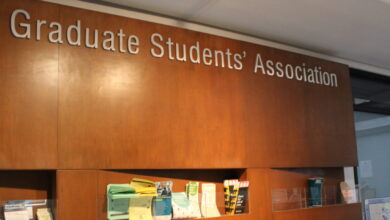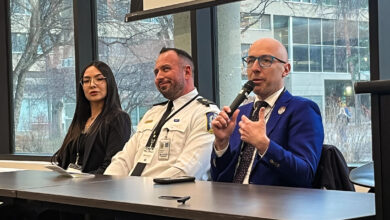Academic restructuring moving ahead: GFC votes to recommend college model proposal
The general faculties council (GFC) passed a motion to recommend the college model for the Board of Governors (BOG) and amended the model’s administrative structure, removing the position of executive deans.
 Helen Zhang
Helen ZhangThe highest academic governing body has chosen to recommend the college model restructuring proposal with some crucial amendments to its administrative plan.
The decision took place during a December 7 meeting, where General Faculties Council (GFC) began by voting on what academic restructuring model they would recommend to the Board of Governors (BoG), the highest decision making body in the university. GFC voted 102-22, with five abstentions, in favour of a college model supported by a service manager and led by a council of faculty deans who would report to the provost.
This model divides the university into a college of health sciences, a college of natural and applied sciences, and a college of social science and humanities, leaving Augustana, Campus Saint Jean, and the Faculty of Native studies independent.
Many council members expressed dissent for the new set of executive deans added in the university’s version of the college model. Executive deans would oversee their respective college’s faculties, controlling each faculty’s budget with final say on academic planning.
At the meeting’s close, GFC voted to recommend an administrative structure without executive deans.
Before amendment, motion supported adding a new level of top administrators, executive deans
The motion brought before GFC changed the title of the executive dean position, referring to them instead as “college deans.”
Steve Dew, the provost and vice-president (academic), elaborated on the executive dean position name change before the amendment was discussed.
“We’ve previously used the term executive dean to describe this position, but have heard pushback that the term executive sounds exorbitant in this current financial situation,” he said.
He elaborated that these new deans would oversee faculty deans, who due to the nature of their roles, would possibly be biased in advocating for their own faculties. Further, he argued that a single leader positioned above faculty deans would be capable of initiating clearer directives.
“It has been suggested by some that we don’t need a college dean, that the function could be filled by a council of deans,” he said. “I would strongly disagree with that. To be effective there needs to be clear responsibility and accountability at the individual level.”
Heather Coleman, a faculty of arts professor, said she was worried about the renaming.
“You can rename it because the word doesn’t sound good, but there are a lot of people who are saying it looks like a duck and it sounds like a duck,” she said.
In the original motion, the executive dean was described as having a responsibility for “fostering interdisciplinary teaching and research” within the college.
Joel Agarwal, president of the Students’ Union, expressed support for an administration that included executive deans, emphasizing a potential for interdisciplinarity.
“I just wanted to bring up that one of the goals of this whole process in addition to the savings has been to increase interdisciplinarity,” he said. “Without an executive dean, … there would not be a person that is dedicated primarily to fostering interdisciplinarity in its teaching and research across the college faculties.”
Coleman, opposed, highlighting that in her experience, interdisciplinarity has not come from high levels of administration, but rather bottom-up.
“I think that all of us who work in the academy know [interdisciplinarity] comes from below,” she said. “Of course, leadership can encourage or discourage it, but it ultimately comes from discovery and relationships.”
GFC rules in favour of amendment of administrative model without executive deans
Eleni Stroulia, professor in the department of computing science, put forward an amendment to the motion on administration that removed the college dean position and replaced it with a service manager who would be responsible for the administration of the college, and would report collectively to the deans of each faculty.
In this model, all faculty deans would report to the university provost, and would retain autonomy in regards to the faculty budget and the faculty’s academic program.
“My amendment does not introduce a new layer of administration,” Stroulia said. “We believe the colleges should focus primarily on administrative efficiencies. We also see that there’s an opportunity for more than that, and we hope that the deans of the college faculties will figure out how to take advantage of these opportunities.”
Fraser Forbes, engineering professor, spoke in favour of Stroulia’s amendment.
“One of the things we keep hearing is somehow we can’t work together, we can’t collaborate,” he said. “My worry is that we’ve fixated on a single model of leadership, because somebody else did it … that may be so, but leadership at the U of A … should be done carefully and thoughtfully, not in a rushed fashion or as part of restructuring at the last minute.”
Forbes said that the amended motion would allow additional time to ensure that the best decision is reached.
“I’m going to be voting for the amendment to give us the breathing space to actually create the right leadership model, rather than a knee-jerk reaction to the first available thing,” he said.
Key Students’ Union members vote against the amendment, remain in minority
Adrian Wattamaniuk, a second-year electrical engineering student, voiced his agreement with the amendment, adding that the additional expense of college deans would be doing students a disservice.
“With each college dean … you’re looking at breaking $1 million per faculty. This isn’t even to mention the potential harms of insulating the faculty deans from the provost and from central administration,” he said. “I believe that the faculty deans can effectively lead their colleges … and will make sure that students are getting the services that they need.”
Wattamaniuk appealed to his fellow student representatives to also back the amendment.
Notably, Students’ Union executive committee members Agarwal and Katie Kidd, the vice-president (student life) were among the few that rejected the amendment. However, vice-president (academic) David Draper voted in favour of the amendment, alongside several other members from student council.
Marc Waddingham, the president of the graduate students’ association (GSA), abstained from voting.
Alongside Students’ Union executives, Andrew Sharman, vice-president (facilities and operations), spoke against the amendment, arguing that there would be too much disagreement among faculties if the amendment was to pass. Additionally, he emphasized the importance of leadership to face the changes the university must make to address budget cuts.
“We want to be able to be seen as a top rank university in the world, not just now but in the future,” he said. “We need to have strong and accountable leadership at the head of these colleges.”
Invisible college model denied, alongside amendment for college of arts and sciences
GFC also voted on an additional amendment to the motion regarding the administrative structure, called the invisible college model, but ultimately voted against it.
While the model shared some commonalities with Stroulia’s proposal, it carried additional conditions that the colleges would be divisions in name only, with faculties remaining the largest academic units at the university.
Additionally, the motion described how the monetary aspects for each college would be determined. For example, the budget for the shared services in each of the colleges would be determined by a committee of the faculty deans, and that the budget would be administered by each college’s services manager.
Carolyn Sale, an arts professor who brought forward the invisible college model, described what she saw as the model’s benefits.
“Let us save the money that we need to save in the face of the disastrous situation that confronts us, without doing any damage to the reputation of our faculties or the university as a whole,” Sale said.
Anastasia Elias, faculty of engineering professor, described how in the last GFC meeting, many members spoke in favour of a council of deans, a leadership structure that the invisible college model didn’t include.
“One thing we heard a lot of at the last GFC meeting was ensuring that the proper leadership was in place,” she said. “In addition … [the motion] also introduces some strange language around budget, so I’ll be voting against this one.”
Another amendment that didn’t pass proposed a college of arts and science instead of a college of natural and applied sciences and a college of social science and humanities.
Christopher Lupke, professor of Chinese cultural studies, spoke in favour of a college of arts and science, outlining how both faculties were united in not being focused on professional training.
“I think … this proposed reorganization will force all of us to become more professionalized and more atomized,” he said.
Matina Kalcounis-Rueppell, dean of science, spoke in support of the college of science and applied sciences, citing that the option could leverage “deep local, provincial, and federal investments,” in addition to incorporating services already shared between science and applied science faculties.
“I think that this is a way forward,” she said. “I’m very hopeful that this college structure and this alignment will in no way further silo us, but instead allow us to have really meaningful conversations about how we move forward with enhancement and opportunity for cross faculty collaboration.”




